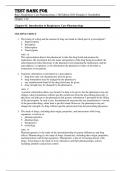Samenvatting
Summary Lecture sensory science Food and Ingredient Categories, Carrier Systems and Food Technology HFV1004
- Instelling
- Maastricht University (UM)
Summary of 13 pages for the course Food and Ingredient Categories, Carrier Systems and Food Technology HFV1004 at UM (lecture)
[Meer zien]













